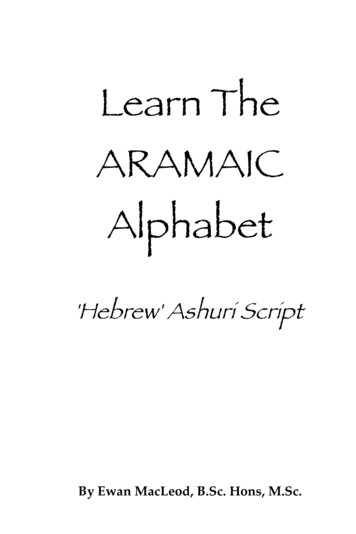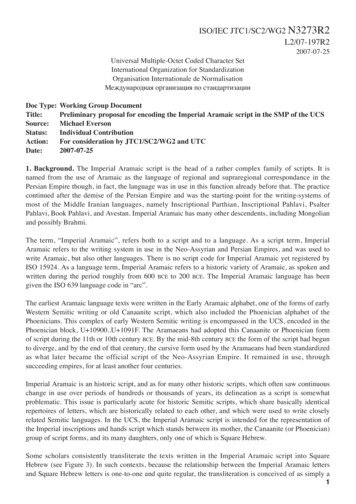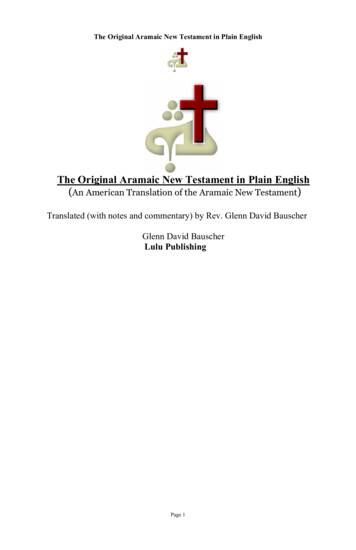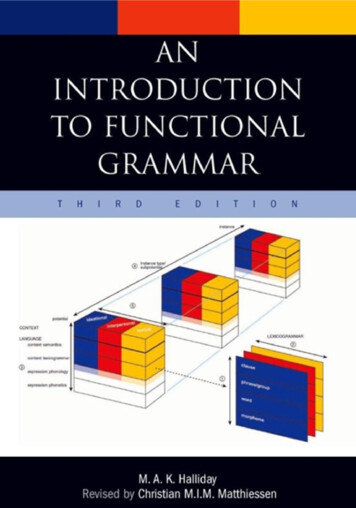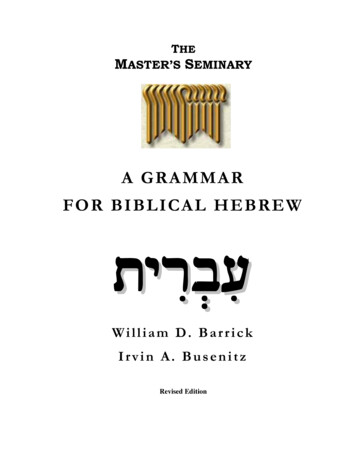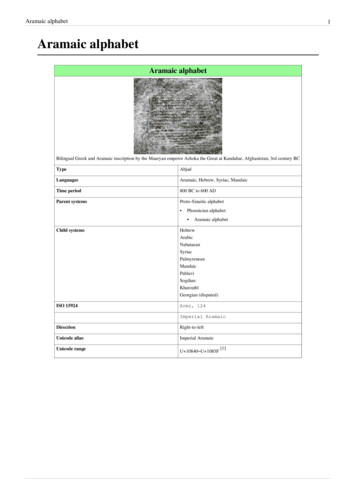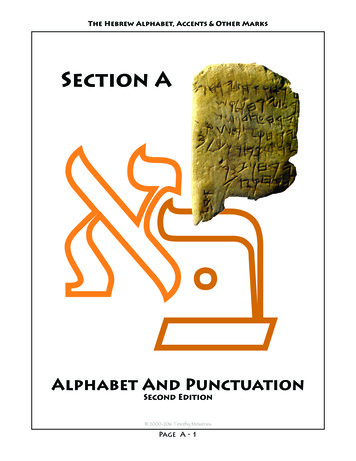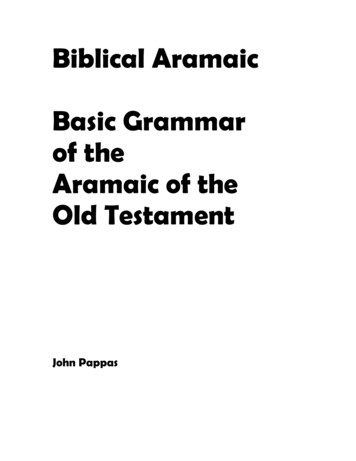
Transcription
Biblical AramaicBasic Grammarof theAramaic of theOld TestamentJohn Pappas
Copyright, 2020byJohn Pappas, Th.M, Th.D
Table of ContentsTHE METHOD . IITHE STORY OF ARAMAIC . 1THE ARAMAIC ALPHABET . 4PRONOUNS . 11INTRODUCTION TO VERBS . 15THE SIMPLE VERB . 19NOUNS . 26THE INTENSIVE VERB . 33ADJECTIVES, CONJUNCTIONS AND PREPOSITIONS . 38THE CAUSATIVE VERB . 42ADVERBS, PARTICLES AND NUMBERS . 46THE WEAK VERBS . 50APPENDIX . 52ANSWERS TO QUESTIONS . 53VOCABULARY . 54VERB CHARTS . 59BIBLIOGRAPHY . 61
PrefaceThe basic idea of any introductory language text is to keep it simple! While keeping itsimple, I have tried to also keep the complexity inherent with Aramaic and Hebrewgrammatical terms simple and unifirm. This simplification is often a hard thing toaccomplish since the student also needs to get aquanted with all the technical termsinvolved yet at the same time not be lost with too many terms which mean the samething.I must thank my Aramaic teacher, David Austin at Tyndale Seminary, FortWorth, for his encouragement with both Hebrew and Aramaic. Also, my doctrinaladvisor and mentor Dr. Mal Couch who spent countless hours discussing language,theology, and life issues. These long discussions instilled in me the “keep it simple,”philosophy that I, in turn, emphisize to my students. It is my hope that the student of thisAramaic grammar will find the complex made simple, while expanding in knowledge andunderstanding of the original author’s meaning. It is not possible to interpret completelythe thoughts of the original author without going to the original author’s language. Thatmeans going back to the often obscure Aramaic text.i
The MethodThe method used for learning the Aramaic of the Old Testament is based on the internetvideo Bible Aramaic VPOD produced by the author. This program is based on the threefundamentals: Chapter reading of the grammar book Video instruction using the Aramaic video lessons Then, back to the book for practice, exercises, and translationsThis method is simple, straight to the point, and proven. It is the purpose of thismethod and program that the student will gain a quick understanding and confidenceworking with the language while the love and value of it grows.Working the practice exercises is extremely valuable. There is no substitute formemorizing the vocabulary and translating the verses. The volume of words to memorizefor each lesson is manageable, and the translation work limited to five or six verses. Usea Bible, in fact several versions of the Bible when translating so as to get acquainted withvariations.May your time be spent in the Word and may the richness and depth of His Wordworking together with the Holy Spirit bless and mature you greatly.ii
Chapter OneThe Story of AramaicAramaic has been traditionally classified as a Northwest Semitic language, this groupincludes the Aramaic and Canaanite dialects. The South Semitic group includes theArabic group and the East Semitic group includes the Akkadian language.PrimaryDialectsEast SemiticAkkadianSouth SemiticArabicNorthwest Semitic1CanaaniteAramaicBabylonianAssyrianNorth ArabicSouth blaicUgariticPhoenicianHebrewAmmoniteMoabiteOld AramaicBiblical AramaicImperial AramaicNabataeanSyriacThe name Aramaic is found in Ezra 4:7 as ‘( א ֲָר ִמית aramiyth) which is the feminine ofAramaean, and translated Aramaic, but the older translations say the ”Syrian language.”In Genesis 10:22, Aram, the youngest son of Shem, is mentioned as the founder of theAramaean nation, and thus the country is rightly called “Aram” (Num. 23:7); but thesame Hebrew word is rendered “Mesopotamia” (Judge 3:10)2. Syria is an abbreviatedform of Assyria and came into common use after the conquests of Alexander the Great.The Aramaic found in Daniel’s day is referred to in Daniel 2:4 as ַּ כַּ ְׂש ִדימָ ה (kasdiymah), or the shortened form ( כ ְׂש ִדי kasdiy) from Kasdites the descendents ofKesed and has come to be known as the Chaldean language common to the region ofBabylonia. The dating of Daniel can be found in the fact that Chaldea was a country thatexisted between the late 10th to early 9th and the mid-6th centuries BC, after which it wasabsorbed into Babylonia. They existed in the marshy land of the far southern corner ofMesopotamia located chiefly on the left bank of the Euphrates and were identified as bothSuteans and Arameans. The Chaldeans originally spoke a West Semitic dialect distinctfrom Aramaic and it was during the Assyrian Empire of king Tiglath-Pileser II that theEastern Aramaic dialect known as the lingua franca dominated the area. Dr. Larry Walkersays, “Although the Aramaeans never possessed a mighty empire, they enjoyed the12Gleason Archer, A Survey of Old Testament Introduction (Chicago:Moody, 1994), p. 18Merrill Unger, The New Unger’s Bible Dictionary (Chicago”Moody, 1988), p. 12321
privilege of imposing their language on the whole Near East. This is undoubtedly partlydue to the fact that they used the alphabetic system of writing in contrast to thecumbersome cuneiform (syllabic) system used in writing Akkadian. As early as the 8thcentury B.C., the Aramaic language competed with Akkadian and thereafter graduallyspread throughout the Near East. When the Achaemenian3 monarchs looked for a tonguewhich could be understood by all their subjects, they chose Aramaic which became thelingua franca of their vast empire. Aramaic attained its maximum diplomatic prestigeduring the Achaemenian Empire of Persia, where it was used as the interprovinciallanguage from India to Egypt between the 6th and 4th centuries B.C.”4It is during the time of Abraham that the Chaldean dialect moves into the Biblicalstory as Abraham originated from Ur of the Chaldees (c. 2000 B.C.; Gen. 11:28-31). AsAbraham moved into the land of Canaan, one finds a unique Hebrew dialect establishedas a distinct branch. Aramaic is sometimes refered to as a Northern dialec of the Semiticbranch of languages and Hebrew is specifically designated as a Northwestern dialect. Allindications are that in the 8th century B.C. Aramaic’s alphabetic system won over themore cumbersome cuneiform of the dominate Akkadian that rulled the day.The earliest Aramaic inscriptions discovered so far come from the ninth centuryB.C.5Aramaic in the BibleAs Dr. Franz Rosenthal observed, “Official Aramaic, when written by people whosenative language was not Aramaic, showed considerable divergences in a number ofaspects, especially in the syntax and the vocabulary . The Aramaic of the Bible aswritten has preserved the Offical Aramaic character. This is what makes it nearly uniformin linguistic appearance. It also makes it largely identical with the language used inOfficial Aramaic texts. Most numerous among these are the Aramaic documents of theAchaemenid period (550-330 BC) discovered in Egypt which are invaluable for theunderstanding of Biblical Aramaic.”6The letters of Biblical Aramaic are the same used in Hebrew. “The so-calledHebrew or square script is, in fact, a Jewish specialization of the older Official (Imperial)Aramaic script adopted by the Jews in the course of their acceptance of Aramaic as theAramaic spoken among them.7The extent of the Aramaic found in the Bible is identified by the following:I. Old Testament1. Genesis 31:47 (two words)2. Ezra 4:8-6:18 and 7:12-26.3. Jeremiah 10:11.4. Daniel 2:4-7:28II. New Testament3Achaemenian dynasty ruled Persia from Cyrus I to Dairus III (553-330 BC).Merrill Tenney, gen. ed., The Zondervan Encyclopedia of the Bible (Grand Rapids:Zondervan, 1976)vol.1, p.2495Franz Rosenthal, A Grammar of Biblical Aramaic (Wiesbaden: CIP, 1995), p. 96Ibid, p. 107Ibid, p.1242
1. Matthew 5:22 (one word, “Raca” “fool”); 27:46 (“Eli Eli lemasabachthani” “My God, my God, why have you forsaken Me?”)2. Mark 5:41; 7:34; 11:9; 14:36 (simple expressions. i.e. “Abba,” “Father”)3. John 20:16 (one word, “Rabbouni” “teacher”)4. 1 Cor. 16:22 (one word, “Maranatha” “our Lord come”)Some of the more notable differences between Aramaic and Hebrew issummarized as follows:81. Consonantal changes.a. The original “th” shifted to “sh” in Hebrew, “t” in Aramaic.b. The original “d” shifted to “ts” in Hebrew, silent ‘ăyĭn or occasionally “q” inAramaic.c. The original “z” shifted to “ts” in Hebrew, “t” in Aramaicd. The original “dh” became to “z” in Hebrew, “d” in Aramaic.2. Vowel changesa. Aramaic perserves the original long “a,” whereas the Canaanite shifted to “o.”b. Aramaic perserves the original “i,” whereas the Hebrew shifted to long “e.”c. Aramaic perserves the original “u,” whereas the Hebrew shifted to long “o.”d. “a” under accent does not lengthen as it does in Hebrew.Important Related DocumentsTogether with the Bible are found several important Aramaic related works. TheseAramaic works are found in the works of their period. Around the time of Christ,Aramaic split into two main branches, East and West. There are two important earlymanuscripts to note, the Jerusalm Targum of the Western branch and the BabylonianTargum representing the Eastern branch (c. 1st century).The Christian Aramaic speaking community created the Peshitta, the AramaicBible (c. 2nd-3rd century).8G.L. Archer in Merrill Tenney, gen. ed., The Zondervan Encyclopedia of the Bible (GrandRapids:Zondervan, 1976) vol.1, pp.251-2523
Chapter TwoThe Aramaic AlphabetThe Aramaic and Hebrew alphabets are the same.LetterFinal tlDdalĕtddalĕthahhē’wzxjyKklmns[PpcqrfvTt9& !@@#Transliteration9Ybv (b)ggh (g)dth ww!yztyx Ityj Idwyvāv (or wāw)10zāyĭnhêttêtyôdv or wzch ( h ̣)t ( t ̣)yvine or wayZionBachtallyes@kkăfkăflāmĕdmēmnûnkch ��tsādêqôfs‘pph (or f)ts ( s ̣)qsinsilentpetfatnetskingrêšsînshîntāv (tāw)tāv (tāw)rssh (š)tth (t)runsinshinetoythronedml m!wn ms!y[aPydc@wqvyr!yf!yvwTTransliteration is the process of assigning an English equivalent to the Hebrew letter.I prefer vav over waw. That is how I learned it so I will continue with that heritage.104
Notice the five groupings. These are organized in four or five letters per group inorder to help in the memorization process. It is far easier to memorize a group of four orfive letters, then, once the group is memorized, move on to the next group. Memorize theletter, saying the name and writing the letter many times. Do this until the whole alphabetcan be written without hesitation.BeGaD KeFaTNotice there are some letters that are repeated and contain a dot (.) within it (e.g., T). Thisdot is called a Daghesh Lene and indicates a hard pronunciation. These letters are calledbegadkephat (a composite built on the names of the six letters tpkdgb) as a way toremember them. These letters are B, G, D, K, P, T. As you can see, Aramaic, like Hebrewis written from right to left.Final FormThere are five letters that contain a final form. A final form letter should be used whenthat letter is in the last position of the word.letterfinal formkmnpc !@#Final kaf has two special forms that come up a lot. Final kaf is written with a silentsheva ( . ) when it lacks a vowel and looks like %. Likewise final kaf has the final qamets( " ) placed inside it and looks like .Certain letters sound alikeAs you can tell some of the letter sound alike. s, f - S, as in See K, q - K, as in keep j, T - T, as in Tom b, w - V, as in Vine x, k - CH, as in Bach a, [ - SilentThe VowelsOur ancient Hebrew and Aramaic text had no written vowels. The written vowels wereadded around AD 500 by the Masoretes who added them in order to preserve the5
language. It is not that the language did not use vowels; it is just that there was no writtenform until later. The speaker would add the vowel as necessary. For example, all verbs(with exception) use the “a” sound in the first syllable while its noun equivalent will usethe “e” sound in the first vowel position. The system they developed is called the pointingsystem whose intention is not to alter the established written form. The pointing addedsmall dots and symbols below and above the character.Aramaic has the “a,” “e,” “i,” “o,” and “u” vowel sounds as shown qQibbutsTable of Full-VowelsSignPosition Sound''aa, as in car:;aa, as in batEeae, as in theyyEyeae, as in they,,ae, as in metyIyIai, as in marineIiai, as in sitIoao, as in rowAAao, as in row''ao, as in costWWau, as in ruleuuau, as in ruleExampleb'a fathert;B daughterlEa GodtyeB housel q v shekelayih she i[ withaol notrAa lightl'K allaWh he!'x.luv tableLong Vowels. The following table lists the Aramaic/Hebrew long vowels.Sign-'eo-qameisisereIholemName#em"qyerec rʼelGodloʼnotNaturally long vowels. The following table lists the Aramic/Hebrew naturally longvowels. Naturally long vowels are formed using either a vav (w) or a yod (y).SignyeyiAWNamedAy yerecisere yoddAy q,ryixhireq yodIholem vav w'w ,lAxq plebeythhiyʼʼorhuʼhouse ofshelightheThe older authors use qā́ mĕs, pắtăh, etc. The spelling is often different depending on the author. Onething the beginning student of Aramaic needs to know is that nothing is consistent between differentauthors.116
Short Vowels. The following table lists the Aramaic/Hebrew short yix@Wj"x #Em"q#WBIqpa;taIhse;golIhireqqameis IhåitufqibbuisăĕĭŏŭSounda, as in bate, as in meti, as in sito, as in costu, as in ruleExamplet;Bl,q,v i[l"K!"x lUvdaughtershekelwithalltableThe Half-VowelsIn addition to vowels, Aramaic, like Hebrew, makes use of semi-vowels or half-vowels.These half vowels make use of the sheva or shewa (a'w v). There are two classes of sheva,the first is the vocal sheva which stands alone and is pronounced like an “e” as in tyir B(berit) pronounced “breet.” It is transliterated as a superscript e as in berit. The other classis a silent sheva which is a sheva placed beneath a consonant that ends a syllable andsometimes placed in the final kaf (%).The other sheva is used as a compound with other vowels and makes a hurriedvowel sound. The compound shevas are as follows:FirstSecondCompoundName:.]?\hI atef - pathaIhIhatef- segholIhatef- qametis 'Sounds likehurried Pathachhurried Segholhurried QametsExampleyIn]avAn?ayIl\xʼaniy“I”eʼ noš “man”Iholi “sickness”Consonants Used as VowelsThe consonants ywha may be used as vowel letters. a and h are used for final ā or ē, w for ōor ū, and y for ī and ē. Final ē, which occurs very rarely, is indicated by h.12Daghesh ForteThe Daghesh forte is a dot in the letter which indicated one is to double the consonant inwhich it occurs. It is the same mark as the daghesh lene placed in the six consonants. Forexample in, !eB;h (habben) the bet is doubled.The rules for a daghesh forte are as follows:1. A dot in any letter other than a BaGad KeFaT letter is a daghesh forte.2. A daghesh forte is always found immediately after a vowel, whereas a dagheshlene is never found after a vowel.12Franz Rosenthal, A Grammar of Biblical Aramaic (Wiesbaden: Die Deutsche, 2002), p. 127
GutturalsThe gutturals are: a, [, h, x, and sometimes r. They are gutturals because they arepronounced from the back of the throat.SibilantsThe sibilants are: z, s, c, f, and v. They are classified as sibilants because of their “s”sounds.LabialsThe labials are: B, m, and P.Furtive PathachWhen a word ends with one of the gutturals or and a Pathach is beneath the finalguttural it is called a Furtive Pathach and the Pathach is pronounced before the finalguttural. An example is :xWr (ruach), “spirit, wind.”SyllablesThe word syllable comes to the English from the Greek syllabē meaning, “that whichholds together,” and applies to how a word is pronounced. A word or part of a wordpronounced with a single, uninterrupted sound of the voice is a syllable. Aramaic wordshave as many syllables as they have separate consonants. In general, words are broken upinto syllables using the following rules: All syllables in a word must begin with a consonant.A syllable must include one full vowel or a half vowel.There are as many syllables as there are full vowels.A syllable will split the doubled letter of a daghesh forte.Aramaic syllables are either open or closed. An open syllable is one that ends in avowel and is normally a long vowel. A closed syllable is one that ends in a consonant andthe vowel will normally be short.Aramaic DifferencesThere are a few things to point out concerning the differences between Aramaic andHebrew. These differences are summarized as follows:1. Hebrew words with zayin (z) may be changed to dalet (d) in ongoldto sacrifice2. Hebrew words with tsade (c) may be changed to tet (j) in Aramaic.8
HebrewrWcAramaicrWjTranslationmountain3. Hebrew words with tsade (c) may by changed to ayin ([) in land, earthtree4. Hebrew words with shin (v) may be changed to tav (t) in llto dwell5. The Aramaic consonants are interchangeable13.aandhvandsAramaic optiona'la'r]h:na.T.v:v.x:T.ra;a'k.Bf:Aramaic optionh'lh'r]h:na.T.sv: .x:T.ra:a'k.Bs:TranslationnotriverArtaxerxesharp6. Hebrew words normally spelled with the long o-class vowel, Holem Vav, may bespelled with the long a-class vowel, Qamets, in Aramaic. This is referred to as theCanaanite shift.14Hebrew Al'vvAn/arADbAjAramaic . The determinate state. The definite article is moved to the end of the word andchanges to Qamets with alef (a' ).Hebrew%,l,M:x1314Aramaica'K.lm:Trnanslationthe kingMiles Van Pelt, Basics of Biblical Aramaic (Grand Rapids: Zondervan, 2011), p. 4Miles Van Pelt, Basics of Biblical Aramaic (Grand Rapids: Zondervan, 2011), p. 109
8. Fewer uses of the vav conjunction (w) in Aramaic than in Hebrew.9. Greater use of the word yiD . The word may be used as a subordinate conjunction(“that, so that, when, after”), a genitive (“that of, which belongs to”), and arelative pronoun (“who, which, that”).10. Common words. Some common words are noticeably different.Common wordto cometo fearto seeto speakto go downAramaichtalxDhzxllmtxnHebrewaAbaEr'yh'a'rr:m'a r:b'Dd:r'yPracticeA.B.C.D.Memorize the consonants.Memorize the vowels.Memorize the half-vowels.Memorize the 9 major differences between Hebrew and Aramaic.10
Chapter ThreePronounsVocabularyb:a!,b iy:x yiK:xh'm.kx' ,lExh'KUnx]l:jD:y Ay!Eh'KfatherstoneGod, godgods, Godcubitlionhouse, templemanjudgment, justicelaw, command,decreepalace, templestrength, armywise, wise manwisdomdreamdedicationdewhand, powerdaypriestThe PronounLike English pronouns, Aramaic pronouns replace a noun. The noun that it replaces iscalled the antecedent. In the statement, yih{l?ah' aWh h'wh y “The LORD, he [is] God” thepronoun “he” refers back to the nearest antecedent “LORD.” The word pronoun comesfrom the Latin pro meaning, “before, for,” and nomen meaning, “a name.” Aramaicpronouns are classified as personal, demonstrative, relative, and interrogative.11
Independent Personal PronounsIndependent personal pronouns are used to reduce repetition. Independent personalpronouns may be used as the subject of the verb but not the object of the verb. They mayalso appear as subjects of a verbless clause. Personal pronouns function as follows:1. First person pronouns “I” and “we” refer to the person speaking.2. Second person pronoun “you” refers to the person being spoken to.3. Third person pronouns “he,” “she,” and “it,” refer to the person or thing spokenof.151cs2ms2fs3ms3fsAramaich'n]a.T.na: fp3mp3fpAramaich'n.xn: ]a!WT.na:!WNia !AMih AMih!yiNaiTranslationweyouyoutheytheyDemonstrative PronounsDemonstrative pronouns serve to point out someone or something being singled out forattention. For example, “this man” points out this specific man. Demonstrative pronounsmay be either near, “this,” or far, “that.”1. Near demonstratives.Aramaich'n.Da'DlEa h,Lea ationthatmsfscp2. Far demonstratives.15cs and cp are common singular and common plural respectively. Common refers to gender covering bothmasculine and feminine subjects.12
Relative PronounThe Aramaic relative pronoun yiD “who, which, that,” introduces a relative clause and thenoun it modifies. The relative pronoun does not possess gender or number; it simplystands alone following the noun it modifies or is attached to the noun with the maqqef.Interrogative PronounsAn interrogative pronoun serves to ask a question. The Aramaic interrogative pronounsdo not possess gender or number and includes the nal SuffixesPronominal suffixes may be attached to verbs, nouns, and prepositions. Aramaicpronominal suffixes have person, gender, and number. When attached to nouns, themeaning is normally possessive and translated “my, his, her.” When attached toprepositions or verbs, the normal meaning is objective and translated “to me, to him, inal mp2fp3mp3fpPronominal our/usyour/youyour/youtheir/themtheir/them13
PracticeA.B.C.D.Memorize the vocabulary.Memorize the independent personal pronouns.Memorize the pronominal suffixes.Translate Daniel 2:4-11.14
Chapter FourIntroduction to VerbsVocabularylOK@:s.Kb't.Kb:b.l Eb][r:b][!iy:[ :l[' :[b:f][h'x,P El.call, every, wholesilverwriting, documentheartprovince, cityword, matterkingbedprophetstream, riverbookscribeservant, slaveopposite, beyondeyeeternity, foreverpeople, nationplant, grassgovernorstatue, imageThe VerbAramaic verb stems mostly follow the form of Hebrew, but the names have changed.Along with the verbal stems listed below, Aramaic verbs have two tenses: Perfect andImperfect; two moods: Imperative and Jussive; three voices: active, passive and reflexive.Also is found the Infinitive and the Participle.I.Aramaic Stems. Aramaic stems correspond to the Hebrew stems except the nameshave changed. The following list gives the technical name which will besimplified for ease of use (e.g. Peʽal Peal, throughout the rest of the book).a. SimpleHebrew StemQalNiphʽalAramaic StemPeʽalPeʽilHithpeʽel (Ithpeel)15Action/VoiceSimple ActiveSimple PassiveSimple Reflexive
b. IntensiveHebrew StemPiʽʽelPuʽʽalHithpaʽʽelAramaic StemPaʽʽelHithpaʽʽal SimpleCausative/Passivec. CausativeHebrewHiphʽilHophʽalII.Tense. Aramaic has two tenses: perfect and imperfect.a. Perfect. The perfect tense indicates completed action or a state of beingcorresponding to the following:i) Present Perfect “I have written.”ii) Simple Past“I wrote.”iii) Past Perfect“I had killed.”iv) Prophetic Perfect. Perfect as a future.3ms3fs2ms2fs1csPerfect Conjugation3mp3fpt: xxx2mp.t / 't xxx2fptE xxx1cpw xxxw xxx!Wt xxxa'n xxxb. Imperfect. The imperfect tense indicates incomplete action or state of being.i) Present “I write,” “I am writing.”ii) Future “I will write.”3ms3fs2ms2fs1csxxx xxx xxx xxx Imperfect Conjugation3mpy!W xxx y3fpt! xxx y2mpt!W xxx t2fp1cpaxxx n16
III.Mood. Aramaic has two moods: imperative and jussive.a. Imperative. The imperative only occurs in the second singular and plural.Note that the second person imperfect may also function as an imperative. Theimperative is translated as: bUT.K “(you) write!”2ms2fsxxxy xxxImperative Conjugation2mpw xxx2fpb. Jussive. Like Hebrew, the jussive only occurs in the third person imperfect.There is a difference in spelling for the plural forms, while the imperfect endsin final nun (!), the jussive omits it. Imperfect : !Wd.baEy “they will perish” Jussive:Wd:baEy “let them perish”IV.Voice. Aramaic has three voices: active, passive and reflexive.a. Active. The subject performs the action: “I write.”b. Passive. An external agent performs the action: “It being written.”c. Reflexive. The subject performs the action on itself: “I write myself.”V.Infinitive. The infinitive is a verbal noun: b:T.kmi “to write.”VI.Participle. The participle is a verbal adjective: bEt'K “writing.”a. The participle has a multi-purpose sense.1. Continuous and habitual action.h'a.V:n.tmi !yik.lm: -l:[ a'm.l'[ t'mAy-!im %'d a't.y.riq yiD Wx:K.v:h.w Wr:Qb: W“and it was found that this city in former times has revolted against kings” (Ezra 4:19)2. Immediate present.yiD a'K.lm: .l h'n.xn: ]a !yi[.dAh.m“we inform the king that ” (Ezra 4:16)3. Simultaneous with the main verb, often translated as a past tense.a'T.v:r.b,n lEb\q'l !'b.t'k.w v'n/a-d:y yiD !'[.B.c,a Wq:P.n h't][v: -H:B“at this very moment a finger came out and wrote” (Dan. 5:5)4. Used freely as a narrative tense (Dan. 3:3-4).VII.Verbs with pronominal suffixes. Suffixes attached to verbs function as accusativesor as direct objects: e.g., “I see you.” There is no pronominal suffix for the 3mpand 3fp, instead the independent personal pronouns AMih, !AMih are used.17
lationyin%HE (after a consonant)yih (after a m.l.vh:!Ak.n l]a.viya'n T.[:dAhAph Perf 2ms p.s. 1csAph Perf 3ms p.s. 2msPeal Perf 3ms p.s. 3msPeal Perf 3ms p.s. 3msAph Perf 3ms p.s. 3fsPeal Imp 3ms p.s. 2mpAph Perf 2ms P.s. 1cp[:d'yjlvr:t'sh'n'b :l'vl:a'v[:d'yyou knew mehe ruled youhe hid himhe built himhe completed herhe asked youyou knew usPracticeA. Memorize the vocabulary.B. Memorize the Perfect and Imperfect conjugations.C. Translate Daniel 2:12-19.16List adapted from Franz Rosenthal, A Grammar of Biblical Aramaic (Wiesbaden, 1995), p. 7518
Chapter FiveThe Simple Elr:Pic!,r,qvaErl:g.r:xWrr'a.v 'l.v Uv!iy;m.v!Evh'n.vman, mankindwood, treeearth, landsonexile, deportationgoldgenerationvisionnightbirdhornhead, chieffootwind, spiritrest, remainspeace, welfarenameheaven, sky (pl)toothyearThe Simple Verb StemsThe Peal, Peil and Hithpeel stems are called the simple verb stems. The Peal is the simpleactive, the Peil is the simple passive, and the Hithpeel (and the rare Ithpeel) is the simplereflexive rative mTable adapted from Basics of Biblical Aramaic, Miles Van Pelt (Grand Rapids: Zondervan, 2011), p.14119
Peal Perfect Strong VerbThe simple perfect active verb stem in Aramaic is called the Peal perfect stem and isidenified by a vocal sheva ( . ) under the first root consonant and a pathach ( : ) under thesecond root consonant. The Peal perfect stem has the following T.b:tK.tEb.tiKhe wroteshe wroteyou wroteyou wroteI wrotePeal t.Ka'n.b:t.Kthey wrotethey wroteyou wroteyou wrotewe wroteb:h.d-yiD El.c d:b[] a'K.l:m r:C,n.d:kWb.n“Nebuchadnezzar the king made an image of gold” (Dan. 3:1)a'Y:n.P.rD: .D.v:xa] :l v:n.kim.l x:l.v a'K.l:m r:C,n.d:kWb.nW“Then Nebuchadnezzar the king sent to gather together the princes ” (Dan. 3:2)Peal Imperfect St
The basic idea of any introductory language text is to keep it simple! While keeping it simple, I have tried to also keep the complexity inherent with Aramaic and Hebrew . The Aramaic Alphabet The Aramaic and Hebrew alphabets are the same. Letter 9Final form Name Transliteration Pronunciation a Y @la Yalĕf silent B y t b bêt b ball b bêt .
